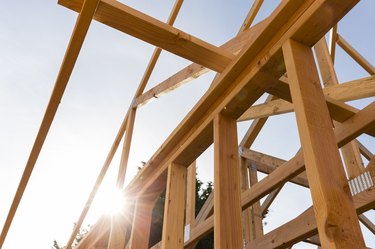
Construction beams are horizontal, weight-bearing supports that bridge an area. Along with posts and columns, which are the beams' vertical counterparts, they support the structural integrity of all sorts of buildings. In homes, you'll find beams in walls, floors, ceilings, roofs, decks and garages. If you're planning to do your own home renovations, consult a structural engineer about what kind of beams to use. But whether you end up installing a new kitchen on your own or hiring a professional, familiarizing yourself with beam basics will help you get a handle on your project.
I-Beams
Video of the Day
As you've probably guessed, this steel beam gets its name from its resemblance to the capital letter "I." You'll usually come across I-beams in big commercial building projects, but they also frame houses, especially interior walls.
Video of the Day
Contractors and builders place I-beams on top of foundation or basement walls, where they provide support to the upper level of the house. They're popular in garages, too, where they serve as tracks or rails for the motorized wheeled trolleys that open and close garage doors.
Flitch Beams
Steel fabrication companies create flitch beams by fastening lengths of wood and metal together. You can nail the wooden section to other structures, while the metal part provides additional strength. The result is lighter than a steel beam but can bear more weight than a wooden one. Flitch beams are particularly useful during renovations involving the removal of a load-bearing wall.
Box Beams
Also known as box girders, box beams are lengths of wood or steel secured at right angles to create what looks like a long, hollow box. Box beams are traditionally made of wood, and three-sided box beams are often attached to ceilings to add visual interest as well as support. Four-sided box beams are also available.
Hip Beams
Hipped roofs have four sloping sides. The "hip" is where different roof sections meet. These roofs require hip beams or rafters. Each hip beam supports several smaller pairs of beams that extend out from it, like branches from a trunk. Wooden beams are traditional, but steel versions are becoming more common as homeowners turn unfinished or outdated attics and lofts into modern living spaces.
Cantilever Beams
You'll find cantilever beams in projecting house elements such as bay windows, balconies, roofs and canopies. Because attached structures support them at just one end, cantilever beams seem to protrude from buildings. A cantilever beam distributes its weight either at or along the unsupported section of the beam.
Bond Beams
Bond beams are beams set within masonry such as stone, clay, brick or cement walls.
Joists
Joists are a group of beams that run in parallel to support horizontal structures like decks, floors or ceilings.
Headers
Headers are weight-bearing beams situated over openings like doors and windows in both exterior and load-bearing interior walls.
Timber
The trunk of a cut-down tree is the source of timber beams, the traditional building material for log cabins as well as houses with timber frame and post-and-beam style construction.
Structural Composite Lumber (SCL)
Manufacturers create these engineered wood products by gluing together thin layers of wood or veneers. SCL makes strong, sturdy beams that don't warp or split. The types of structural composite lumber include laminated strand lumber (LSL), laminated veneer lumber (LVL), oriented strand lumber (OSL) and parallel strand lumber (PSL).
Glued Laminated Timber (Glulam)
Manufacturers glue together layers of wood to produce this strong and versatile wood product. Visually appealing glulam can even work for curved beams, and you might catch a glimpse of these beams in vaulted ceilings.
- Britannica: Beam
- NearSay: What Role Do Steel Beams Play in Home Construction?
- U.S. Waterproofing: Basement Beam Replacement: How Much Does it Cost?
- Metals Depot: Steel Beams
- Lowe’s: Garage Door Opener Buying Guide
- My Rooff.com: Hip Roof Design and Construction
- Quality Decking: Decking Terminology
- Wood University: Glossary
- APA - The Engineered Wood Association: Structural Composite Lumber
- APA - The Engineered Wood Association: Glulam
- International Log Builders’ Association: Glossary of Log Building Terms
- Britannica: Veneer
- Britannica: Cantilever
- ArchiExpo: Concrete Beams